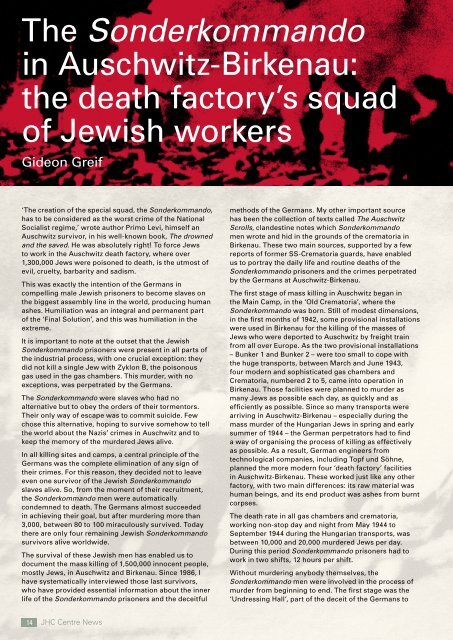CentreNews_2014_Issue1
CentreNews_2014_Issue1
CentreNews_2014_Issue1
You also want an ePaper? Increase the reach of your titles
YUMPU automatically turns print PDFs into web optimized ePapers that Google loves.
The Sonderkommando<br />
in Auschwitz-Birkenau:<br />
the death factory’s squad<br />
of Jewish workers<br />
Gideon Greif<br />
‘The creation of the special squad, the Sonderkommando,<br />
has to be considered as the worst crime of the National<br />
Socialist regime,’ wrote author Primo Levi, himself an<br />
Auschwitz survivor, in his well-known book, The drowned<br />
and the saved. He was absolutely right! To force Jews<br />
to work in the Auschwitz death factory, where over<br />
1,300,000 Jews were poisoned to death, is the utmost of<br />
evil, cruelty, barbarity and sadism.<br />
This was exactly the intention of the Germans in<br />
compelling male Jewish prisoners to become slaves on<br />
the biggest assembly line in the world, producing human<br />
ashes. Humiliation was an integral and permanent part<br />
of the ‘Final Solution’, and this was humiliation in the<br />
extreme.<br />
It is important to note at the outset that the Jewish<br />
Sonderkommando prisoners were present in all parts of<br />
the industrial process, with one crucial exception: they<br />
did not kill a single Jew with Zyklon B, the poisonous<br />
gas used in the gas chambers. This murder, with no<br />
exceptions, was perpetrated by the Germans.<br />
The Sonderkommando were slaves who had no<br />
alternative but to obey the orders of their tormentors.<br />
Their only way of escape was to commit suicide. Few<br />
chose this alternative, hoping to survive somehow to tell<br />
the world about the Nazis’ crimes in Auschwitz and to<br />
keep the memory of the murdered Jews alive.<br />
In all killing sites and camps, a central principle of the<br />
Germans was the complete elimination of any sign of<br />
their crimes. For this reason, they decided not to leave<br />
even one survivor of the Jewish Sonderkommando<br />
slaves alive. So, from the moment of their recruitment,<br />
the Sonderkommando men were automatically<br />
condemned to death. The Germans almost succeeded<br />
in achieving their goal, but after murdering more than<br />
3,000, between 80 to 100 miraculously survived. Today<br />
there are only four remaining Jewish Sonderkommando<br />
survivors alive worldwide.<br />
The survival of these Jewish men has enabled us to<br />
document the mass killing of 1,500,000 innocent people,<br />
mostly Jews, in Auschwitz and Birkenau. Since 1986, I<br />
have systematically interviewed those last survivors,<br />
who have provided essential information about the inner<br />
life of the Sonderkommando prisoners and the deceitful<br />
methods of the Germans. My other important source<br />
has been the collection of texts called The Auschwitz<br />
Scrolls, clandestine notes which Sonderkommando<br />
men wrote and hid in the grounds of the crematoria in<br />
Birkenau. These two main sources, supported by a few<br />
reports of former SS-Crematoria guards, have enabled<br />
us to portray the daily life and routine deaths of the<br />
Sonderkommando prisoners and the crimes perpetrated<br />
by the Germans at Auschwitz-Birkenau.<br />
The first stage of mass killing in Auschwitz began in<br />
the Main Camp, in the ‘Old Crematoria’, where the<br />
Sonderkommando was born. Still of modest dimensions,<br />
in the first months of 1942, some provisional installations<br />
were used in Birkenau for the killing of the masses of<br />
Jews who were deported to Auschwitz by freight train<br />
from all over Europe. As the two provisional installations<br />
– Bunker 1 and Bunker 2 – were too small to cope with<br />
the huge transports, between March and June 1943,<br />
four modern and sophisticated gas chambers and<br />
Crematoria, numbered 2 to 5, came into operation in<br />
Birkenau. Those facilities were planned to murder as<br />
many Jews as possible each day, as quickly and as<br />
efficiently as possible. Since so many transports were<br />
arriving in Auschwitz-Birkenau – especially during the<br />
mass murder of the Hungarian Jews in spring and early<br />
summer of 1944 – the German perpetrators had to find<br />
a way of organising the process of killing as effectively<br />
as possible. As a result, German engineers from<br />
technological companies, including Topf und Söhne,<br />
planned the more modern four ‘death factory’ facilities<br />
in Auschwitz-Birkenau. These worked just like any other<br />
factory, with two main differences: its raw material was<br />
human beings, and its end product was ashes from burnt<br />
corpses.<br />
The death rate in all gas chambers and crematoria,<br />
working non-stop day and night from May 1944 to<br />
September 1944 during the Hungarian transports, was<br />
between 10,000 and 20,000 murdered Jews per day.<br />
During this period Sonderkommando prisoners had to<br />
work in two shifts, 12 hours per shift.<br />
Without murdering anybody themselves, the<br />
Sonderkommando men were involved in the process of<br />
murder from beginning to end. The first stage was the<br />
‘Undressing Hall’, part of the deceit of the Germans to<br />
14<br />
JHC Centre News


